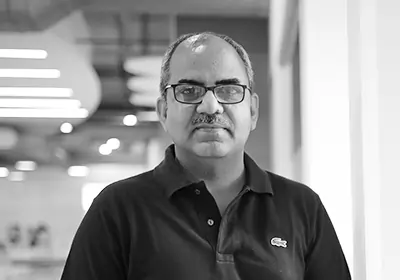Episode 35
End-to-end pull distribution: From pilot phase to scale up
Category : Sales & Distribution
In the previous episode of this series, we discussed the challenges and probable pitfalls of implementing a pull distribution strategy as against a conventional push system. We left off the discussion at the end of the pilot phase. In this episode, we chart out the journey from the end of the pilot phase to the scale-up phase and look at how the nature of challenges change in this phase. We conclude by discussing how these can be tackled to ensure speed and effectiveness of this transformation journey. Find out more about implementing the pull distribution system here: https://www.vectorconsulting.in/research-publications/consumer-goods-and-retail/the-road-less-travelled/
Transcript
| Shubham Agarwal : | Hello and welcome to counterpoint Podcast. I’m Shubham Agarwal and we are back in another episode with Sumit Sharma like we had promised, on the challenges of the implementation phase of an end to end strategy of push to pull. Now, we left it at a point where we discuss how would the scale up happen, the pilot phase is complete, and now how do we reach the scale up phase? So, let’s welcome Sumit and discuss it further. Hi, Sumit, we had left as we had discussed, you know, in the last episode on the pilot phase, so, I want to start by asking what is the real challenge of scale up. |
| Sumit Sharma : | So, when you think about scale up, you know, what happens is on one side, there is the enthusiasm of people looking at the great results which have been achieved in the pilot. But on the other side, there are also certain fears and you know, apprehensions right. So, if you look, the fear would be like, you know, is there going to be some loss of sales during the transition? Is there going to be a lot of inventory correction? Because, you know, in a push environment, normally the people are carrying very high inventory, right? How will we make sure that we don’t lose sales during the transition? So, in fact, these fears, whatever the people have, are actually more of myths, you know |
| Shubham Agarwal : | Sumit, could you give an example here. |
| Sumit Sharma : | If you see when people think that would there be a loss of sales, because of the inventory correction that is going to happen when we shift from push to pull, or the typical J curve, right? That actually, you know, does not materialise, why because in a push environment, the mismatch of inventory at the distribution points is so high that there are huge stocks for certain SKUs and almost NIL or very negligible stocks for a lot of other SKUs. So, when you institute a proper pull mechanism, and go for replenishment, you actually end up supplying a lot of SKUs, because the range increase happens on a very healthy scale. Right. |
| Shubham Agarwal : | So, so, does that mean that the J curve doesn’t really happen, is it? |
| Sumit Sharma : | So if you would have heard you know that this is the typical example or the you know consolation, which people give when the government is constructing a flyover that for a better tomorrow, please suffer today, right, because when a flyover is constructed, they dig up the roads and the you know, the traffic jams, and all those have to be endured for a long time, right. And then only when you get the flyover done, the traffic eases out, but this J curve thing doesn’t happen when you shift from push to pull. So, in fact, the bigger challenges are something where what we discussed in the beginning, that you know, this is all about the paradigm ships, right. |
| Shubham Agarwal : | So then that means that you know, all of these are more like myths. So, so then my question is, what is the real core challenge, then. |
| Sumit Sharma : | You know, the, the core challenge in scale up is the conflict that we land up in, where on one side is the speed of scale up that we are desiring, and on the other side, is the effectiveness of the implementation that we need. And if we look at this conflict on one side, if we are trying to speed up without, you know, giving up on the speed, there is a chance that we might land up into an accident, right? Why? Because as we said in the beginning, the paradigm shift of the key stakeholders who are going to implement it is the most important factor which is going to drive the implementation, because we do not want to, we do not want to lose on the effectiveness part at all, right? And this bandwidth of the change agents is what is the real challenge? Why? Because developing it requires day in and day out hand holding, right? So as we say that rubber gets deformed slowly. The scale up also happens in a way where we are able to, you know, change the mindset and the paradigms of the key stakeholders who are going to lead the implementation on the ground. |
| Shubham Agarwal : | Hmm, right. So Sumit, I think then the question arises that, how do we increase the pace of the implementation? Because I think that must be a big requirement for every organisation, right? |
| Sumit Sharma : | So now, if you look at it, how, how can we increase the pace of the scale up is by getting more and more people really convinced about the solution or have the conviction about the solution and this happens when we are using the earlier implementers as the coaches for the people who are now getting into implementation. So, it is a kind of a train the trainer concept that we apply, and by using this train the trainer core concept, we are able to multiply the number of people who can go and implement well on the ground, right. So, this takes the form of a geometric progression, and we we end up you know, having a good enough pace of scaling up the solution. Right. So, what I understand is that the scale up happens at a different pace than what we might have decided and it is not really hurried, but then what is the real challenge there in the in the entire implementation phase? |
| Sumit Sharma : | The real challenge here is to ensure that the next jump will be higher than what we are achieving today. Now, how do we how do we manage it, what we what we do is that we are constantly getting the data from the implementation stage and analysing it for any gaps. Based on these gaps, we are constantly acting on it to close it. Now, this is what we call as a process of ongoing improvement, or poogi, or what other people normally call as continuous improvement. And in fact, if you see, this continuous improvement is the is the real purpose of management, isn’t it? |
| Shubham Agarwal : | So Sumit this, you know, this sounds like a long drawn journey. And I don’t know when would the results flow in? How would the results flow in? So how long is this journey to achieve the success and the you know, numbers that we have, probably projected. |
| Sumit Sharma : | So if you see the results start coming right from the pilot phase onwards. But if you ask me about the length of the journey, I would say that it is not a long but a never ending journey, but, a happy one. And at the same time, this is the journey which leads the company to become ever flourishing. |
| Shubham Agarwal : | Well, that’s great Sumit. I think this sounds really promising. Thank you for that discussion and for taking us through the challenges of the implementation phase. And not just that, but also helping us understand the phases that come in the implementation phase itself, you know, the pilot and the scale up. So I hope for all the listeners, it would be much more clear now. And like always, if you have any doubts or concerns, questions you can write to us, and we will definitely address your queries. Thank you. This is Shubham signing off. Until next time, bye bye |
Comments
Related Information
Get in touch
Registered Office:
Vector Management Consulting Pvt. Ltd.
10th floor, Thane One, DIL Complex,
Ghodbunder Road, Majiwada,
Thane (West), Maharashtra - 400610, India.
Vector Management Consulting Pvt. Ltd.
10th floor, Thane One, DIL Complex,
Ghodbunder Road, Majiwada,
Thane (West), Maharashtra - 400610, India.








